
Here are some closeups of my corals:
The green polyp Toadstool
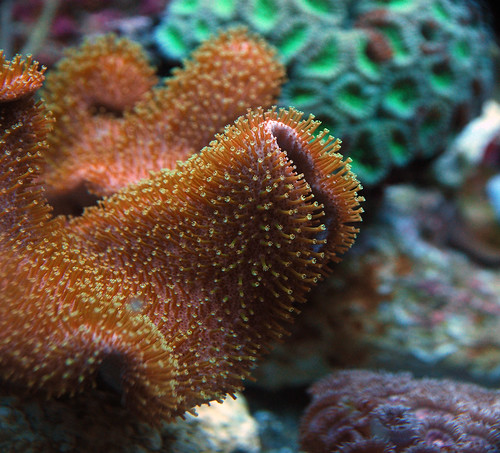
Pink Zoanthus
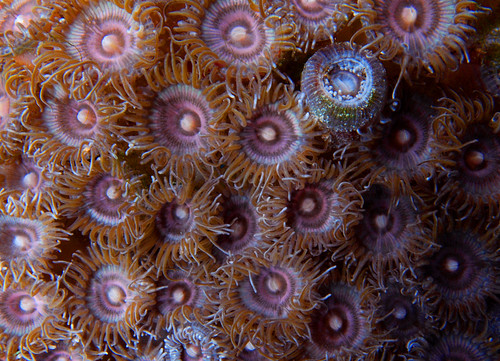
Super neon green Leptoseris
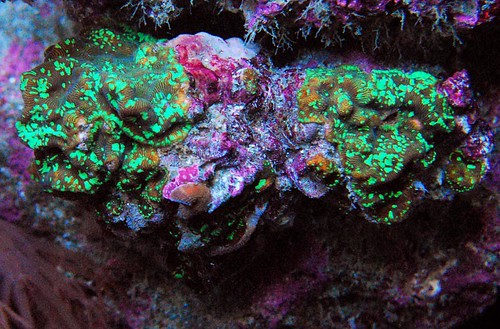
Pumping Xenia

Purple Blastomussa frag

Peanut Butter Cup Zoas
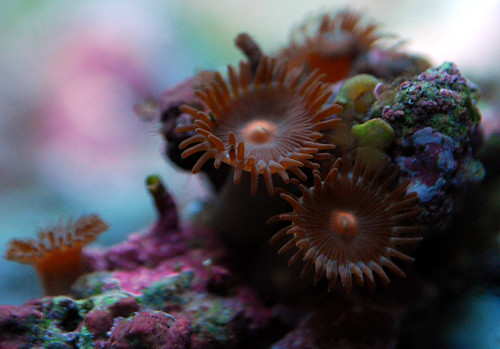
Green Favia lizardensis
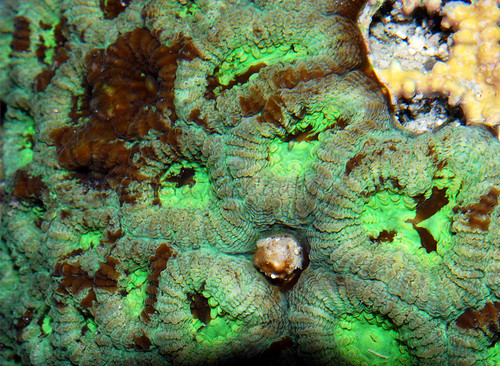








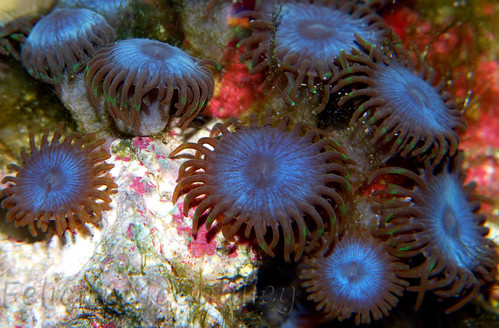
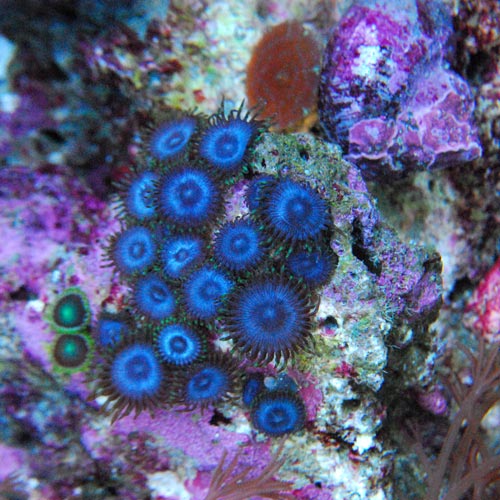


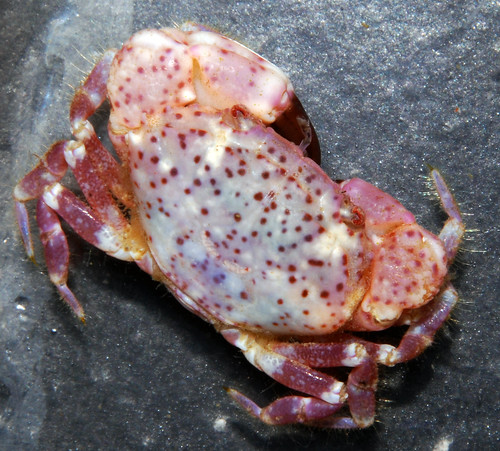
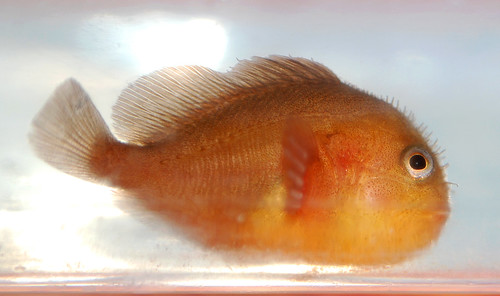
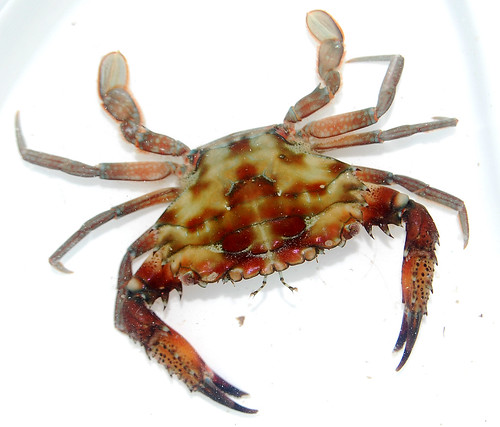
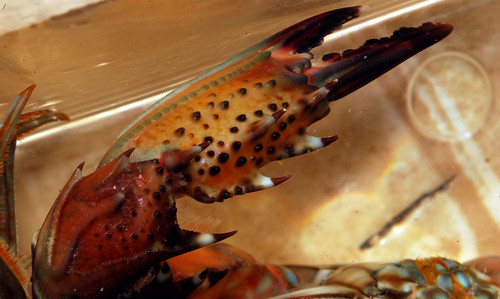

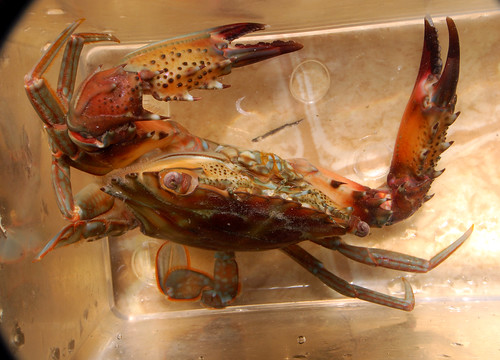


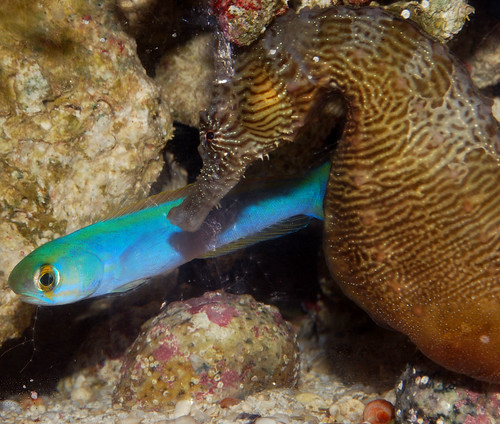 For the first two weeks, though, he hid under a rock and I had to target feed him. It didn't take him long to recognize me as the mysis dispenser, and he would come out from under his rock a few inches to eat. He's even started coming out of hiding any time I walk up to the tank, hoping to be fed. Today he was comfortable enough to swim further from his hiding place and explored the whole left side of the tank. I'm really happy he's doing so well.
As you can see, tilefish and seahorses make great companions. Above is a picture of Blinky and Juniper, my adult male H. erectus seahorse, sharing a meal together. This blue color with the green dorsal is Blinky's default coloration. When he gets excited or scared, he starts rapidly flashing all different vivid colors - pink, yellow, green purple...it's incredible. My boss had one of these for years and said that after a while, it stopped flashing and just stayed blue all the time. It's still a gorgeous fish even when it gets comfortable enough to stop flashing.
For the first two weeks, though, he hid under a rock and I had to target feed him. It didn't take him long to recognize me as the mysis dispenser, and he would come out from under his rock a few inches to eat. He's even started coming out of hiding any time I walk up to the tank, hoping to be fed. Today he was comfortable enough to swim further from his hiding place and explored the whole left side of the tank. I'm really happy he's doing so well.
As you can see, tilefish and seahorses make great companions. Above is a picture of Blinky and Juniper, my adult male H. erectus seahorse, sharing a meal together. This blue color with the green dorsal is Blinky's default coloration. When he gets excited or scared, he starts rapidly flashing all different vivid colors - pink, yellow, green purple...it's incredible. My boss had one of these for years and said that after a while, it stopped flashing and just stayed blue all the time. It's still a gorgeous fish even when it gets comfortable enough to stop flashing.
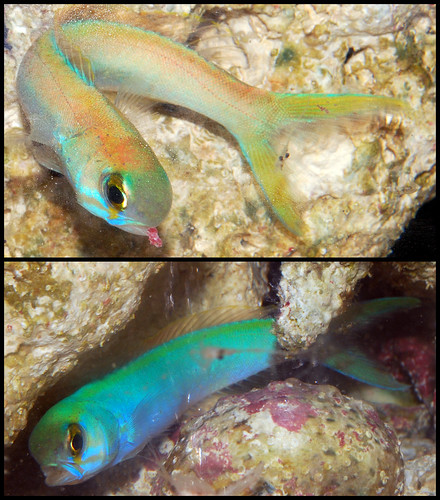 One reason tilefish are difficult to keep is because they are so shy. They should have the most peaceful tank mates like seahorses and gobies. Flashing Tilefish are especially delicate because they are deepwater fish living in waters over 100 feet deep. This is what causes their higher price tag; deepwater fish are more costly because it's more risky to dive for them. Once they are collected, they have to be slowly acclimatized to lower pressure or they will die. A Flashing Tilefish will set you back about $150 or more. But if you can find a healthy specimen, they are worth it.
Flashing Tilefish must be kept in an aquarium with a tightly closed lid. Any tiny holes in the canopy or top for tubes or cords should be well covered. The number one cause of death for Tilefish after being acclimated is from carpet surfing - jumping out of the aquarium.
December Update: Blinky is doing so great, I just love him. His favorite activity is definitely eating. He nibbles on the end of the feeding syringe or my fingers when I feed. He has no fear now and swims around all the time. He has filled out really nicely and has a fat belly.
Check out these Youtube videos of Flashing Tilefish changing colors:
One reason tilefish are difficult to keep is because they are so shy. They should have the most peaceful tank mates like seahorses and gobies. Flashing Tilefish are especially delicate because they are deepwater fish living in waters over 100 feet deep. This is what causes their higher price tag; deepwater fish are more costly because it's more risky to dive for them. Once they are collected, they have to be slowly acclimatized to lower pressure or they will die. A Flashing Tilefish will set you back about $150 or more. But if you can find a healthy specimen, they are worth it.
Flashing Tilefish must be kept in an aquarium with a tightly closed lid. Any tiny holes in the canopy or top for tubes or cords should be well covered. The number one cause of death for Tilefish after being acclimated is from carpet surfing - jumping out of the aquarium.
December Update: Blinky is doing so great, I just love him. His favorite activity is definitely eating. He nibbles on the end of the feeding syringe or my fingers when I feed. He has no fear now and swims around all the time. He has filled out really nicely and has a fat belly.
Check out these Youtube videos of Flashing Tilefish changing colors:
 Welcome to Felicia's Aquarium Adventures, your number one source for pet Crinoid Squat Lobster information!
Welcome to Felicia's Aquarium Adventures, your number one source for pet Crinoid Squat Lobster information!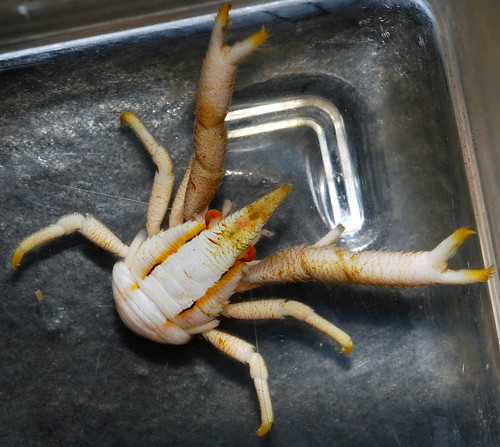
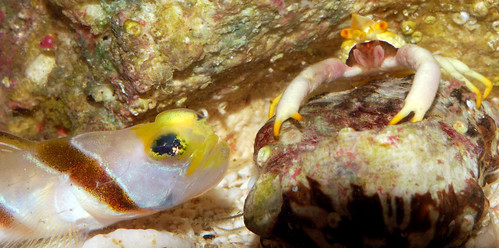
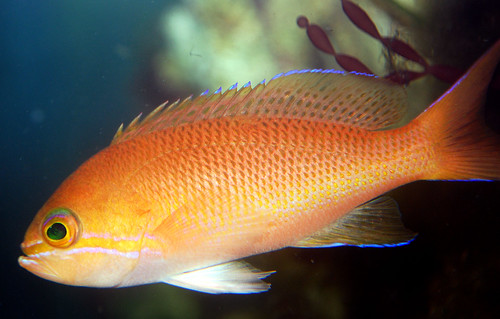
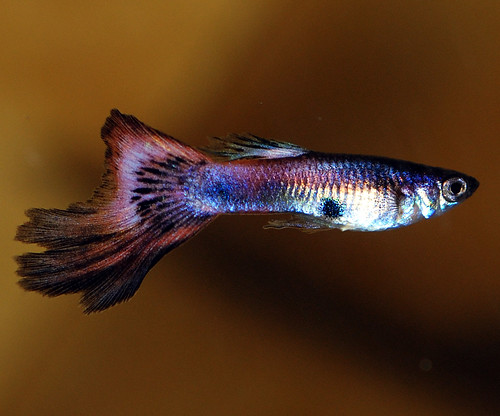

 |
| Blue Eyed Crab |
 |
| red Xanthid crab |
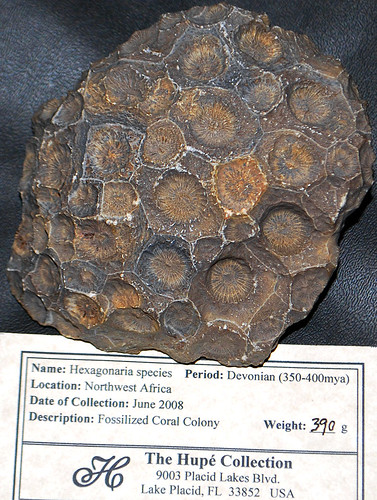



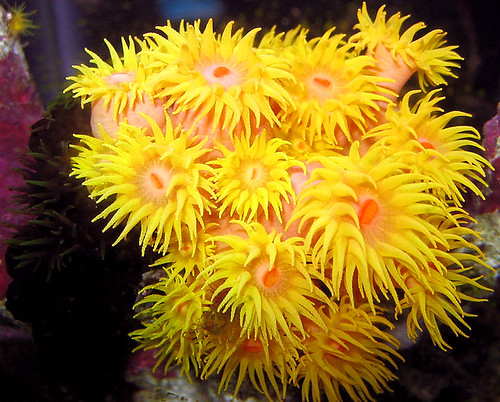
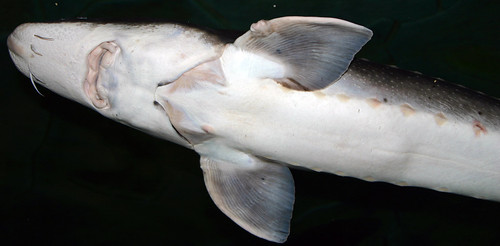
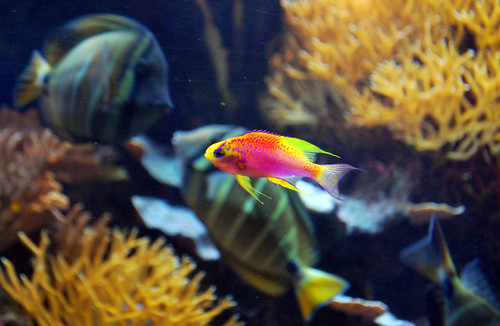

 What really amazed me was that the Shedd has been spawn collecting Acropora palmata corals from the Caribbean. Like all Caribbean stony corals, Acropora plamata is illegal to collect, which is why I've never seen one in person. These larger pieces pictured are about two years old.
What really amazed me was that the Shedd has been spawn collecting Acropora palmata corals from the Caribbean. Like all Caribbean stony corals, Acropora plamata is illegal to collect, which is why I've never seen one in person. These larger pieces pictured are about two years old. I mentioned that it's too bad that A. palmata isn't more colorful, but at least some of the smaller pieces had green or purple colored polyps. They said that A. palmata doesn't have colored polyps in the wild, but after DNA analysis of the symbiotic Zooxanthellae algae (what gives coral its color), they found that the sexually reproduced pieces were taking in Zooxanthellae from Pacific speices of coral. That is what is giving them the colored polyps, and also makes them hardier.
I mentioned that it's too bad that A. palmata isn't more colorful, but at least some of the smaller pieces had green or purple colored polyps. They said that A. palmata doesn't have colored polyps in the wild, but after DNA analysis of the symbiotic Zooxanthellae algae (what gives coral its color), they found that the sexually reproduced pieces were taking in Zooxanthellae from Pacific speices of coral. That is what is giving them the colored polyps, and also makes them hardier.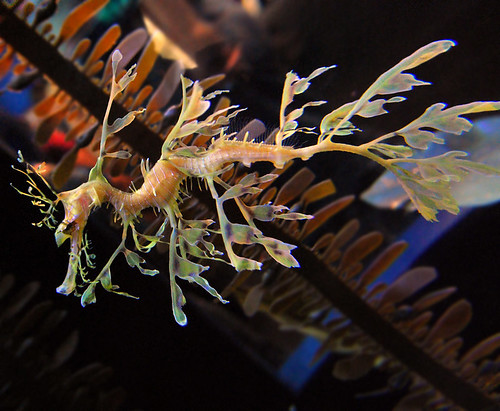

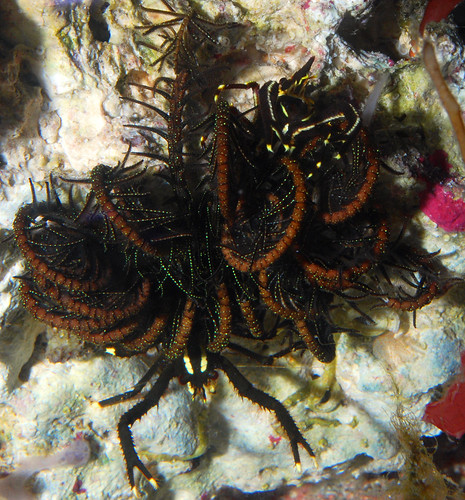

by Felicia M. on August 12, 2009
I’m the photographer at Liveaquaria’s Aquaculture Coral and Marine Life Facility, and I’ve always been fascinated by aquatic animals. Right now I have three aquariums – a chilled “deepwater” aquarium, a coral-only nano bullet tank, and a planted livebearer tank.
My favorite fish are my seahorses, of course. In the wild seahorses are cryptic and rarely seen, but captive seahorses can be very friendly. Mine love to hitch on my fingers when I feed them or do tank maintenance. If you have fish at home, you’ve probably seen them swim at the front of the glass begging for food. Imagine how funny it is to see a seahorse do that. Despite being poor swimmers, seahorses are great dancers with elaborate courtship and greeting dances. They even dance to greet me when I come home.
Contrary to popular belief, captive bred seahorses are not difficult to keep, as long as you are well prepared for them. They have different requirements and are prone to different diseases than other fish, so you might have to first unlearn what you already know about fish to understand seahorse care. Seahorse.org is a great place to go if you want to learn more.
I have five seahorses, three females and two males, living in a 55 gallon aquarium with a 20 gallon sump. Their peaceful tank mates include many small gobies, pipefish, flasher wrasses, non-photosynthetic corals and inverts, and small crustaceans. I tried photosynthetic corals in this tank, but they were overwhelmed by algae due to the heavy feedings seahorses require and had to be moved to their own tank. It’s better this way, since now I can have LPS corals and anemones, which are dangerous to seahorses.
You don’t need a lot of expensive equipment for a seahorse aquarium, but in my experience, a reliable chiller is the most important piece of equipment on a seahorse aquarium. I’m convinced that having a chiller has saved the lives of two of my seahorses and one of my pipefish (more on that later). I also have a Hydor Performer skimmer, Fluval 405 filter, and compact fluorescent lighting.
In future posts, I’ll be sharing more photos and information about each of my aquariums and what has worked well for me. I’ll also tell you about some mistakes I’ve made and how you can avoid them.
by Felicia M. on February 1, 2010
 If you’re an aquarist, you probably have a preference for a certain type of fish. Some people like little peaceful fish, some like big aggressive fish, and others like rare oddball fish. I’ve always been inclined toward small, weird, peaceful fish like Seahorses and Curious Wormfish. I never imagined myself wanting a large predator like a Lionfish until I met “Serendipity.”
If you’re an aquarist, you probably have a preference for a certain type of fish. Some people like little peaceful fish, some like big aggressive fish, and others like rare oddball fish. I’ve always been inclined toward small, weird, peaceful fish like Seahorses and Curious Wormfish. I never imagined myself wanting a large predator like a Lionfish until I met “Serendipity.”
Serendipity is a Yellow Dwarf Fuzzy Lionfish (Dendrochirus brachypterus). I know Serendipity is a female because she has only five bars on her pectoral fins; males have more. Yellow is a rare color for this type of fish, and she is a gorgeous shade of yellow. In addition to her yellow fins, she has beautiful blue eyes and reddish-brown bars on her body.
 Serendipity is the only fish in the coral tank I keep in my kitchen. I think she likes being in the kitchen as she gets lots of attention and can be where the action is. She has been outgoing and friendly since day one. If I am looking into the tank, there is usually a curious little Lionfish face right in front of what I’m trying to look at. I suppose I wouldn’t be afraid of anything either if I were that venomous. I have to be careful when I work in my tank so that I don’t bump into her venomous spines. If I am stung, I’ll put the affected area into water that is as hot as I can stand it, and that may help deactivate the venom. If not, I’d have to take a trip to the ER.
Serendipity is the only fish in the coral tank I keep in my kitchen. I think she likes being in the kitchen as she gets lots of attention and can be where the action is. She has been outgoing and friendly since day one. If I am looking into the tank, there is usually a curious little Lionfish face right in front of what I’m trying to look at. I suppose I wouldn’t be afraid of anything either if I were that venomous. I have to be careful when I work in my tank so that I don’t bump into her venomous spines. If I am stung, I’ll put the affected area into water that is as hot as I can stand it, and that may help deactivate the venom. If not, I’d have to take a trip to the ER.
Serendipity is also unusual for a Lionfish because she eats frozen food. Most Lionfish will only eat live foods. The “fish guys” here at LiveAquaria’s Aquaculture Coral and Marine Life Facility do their best to try to train the large predatory fish to eat frozen foods like frozen silversides and krill before being sold on Diver’s Den. I was lucky that Serendipity learned to eat frozen food.
I feed her a diet of mostly thawed, cut up silversides three times a week. Sometimes she gets a piece of krill as a treat since a diet of krill only has been reported as a cause for lockjaw in large predatory fish. I use a blunt bamboo stick to transfer the food to her. I impale the food on the end then wiggle the food in the water to entice her. She swims up to the food and pauses for a moment while flaring and vibrating her fins before striking. I try to let the food go off the stick in front of her face right before she strikes so she doesn’t hurt her mouth on the stick. We both have to have perfect timing or else the food floats to the bottom of the tank where she won’t eat it and I’ll have to get it out.
Do you have a Lionfish or other large predatory fish in your aquarium? We’d love to hear about it!
by Felicia M. on January 14, 2010
 I was walking through our Aquaculture Coral & Marine Life Facility the other day when a beautiful coral caught my eye. It was a Heteroxenia, a soft coral closely related to Xenia. Usually Heteroxenia spp. are tan or silver, but this one was purple! I soon found out that this was going to be a new Drs. Foster & Smith Certified Captive Grown Coral frag.
I was walking through our Aquaculture Coral & Marine Life Facility the other day when a beautiful coral caught my eye. It was a Heteroxenia, a soft coral closely related to Xenia. Usually Heteroxenia spp. are tan or silver, but this one was purple! I soon found out that this was going to be a new Drs. Foster & Smith Certified Captive Grown Coral frag.
It’s exciting when we offer a new aquacultured coral frag; everyone is involved with fragging, caring for, or naming the new coral. It’s not easy coming up with a catchy name that captures the color and form of the coral. I’m not very creative, so I usually try to leave the naming to my more creative co-workers. Chris M. and I were looking at the coral when we both said, “This coral sure does look like an Octopus.” That’s when it hit me – Octopus ink is purple, and each polyp of this coral has eight tentacles, just like an Octopus! That’s why we decided to call it the Octopus Ink Heteroxenia.
The brand new Octopus Ink Heteroxenia is for sale right now on Liveaquaria.com. I have some Pumping Xenia in my home aquarium that I find to be relatively hardy and fast-growing, so you can bet I’ll soon be buying one of these beauties.
Leave a comment and tell us what you think of the new Octopus Ink Heteroxenia.
by Felicia M. on November 2, 2009
 It’s hard to think of fish as having personalities or being interactive. Before I had seahorses I thought they were neat looking, but I just assumed they sat around and didn’t actually DO anything all day. After caring for my seahorses for over a year now, I feel they are “pets” more so than any other fish I’ve ever kept. I’m certainly not going to claim that seahorses are intelligent, because, well, they’re not. However, they definitely have what I call personality.
It’s hard to think of fish as having personalities or being interactive. Before I had seahorses I thought they were neat looking, but I just assumed they sat around and didn’t actually DO anything all day. After caring for my seahorses for over a year now, I feel they are “pets” more so than any other fish I’ve ever kept. I’m certainly not going to claim that seahorses are intelligent, because, well, they’re not. However, they definitely have what I call personality.
Unlike other fish, seahorses have a prehensile tail they use to hitch themselves to rocks and plants. This strange appendage is what enables their unique, laid-back fish lifestyle. They are able to use their tails to hold perfectly still while hunting. Their tails also make it easy for them to keep in close contact with their friends, as you can see in the photo above. They aren’t in stealth mode all the time, though. They aren’t the best swimmers, but they love to swim, dance, and play.
 My favorite seahorse is a little erectus named Kuiter (named after the biologist, of course). I’m convinced that Kuiter recognizes me and knows who I am (the mysis dispenser!). She follows me around as I work on the tank, swimming against the glass as close as she can get to me. Kuiter even likes to hitch on my fingers. I attribute this behavior partly to the fact that she is captive bred. Captive bred seahorses are used to humans and can become very friendly. This has been helpful on a few occasions when I had to handle Kuiter to medicate her. If she wasn’t used to my hands, the stress from the situation could have been fatal.
My favorite seahorse is a little erectus named Kuiter (named after the biologist, of course). I’m convinced that Kuiter recognizes me and knows who I am (the mysis dispenser!). She follows me around as I work on the tank, swimming against the glass as close as she can get to me. Kuiter even likes to hitch on my fingers. I attribute this behavior partly to the fact that she is captive bred. Captive bred seahorses are used to humans and can become very friendly. This has been helpful on a few occasions when I had to handle Kuiter to medicate her. If she wasn’t used to my hands, the stress from the situation could have been fatal.
Inter-seahorse relationships are pretty complex and fascinating. I have two boys, Juniper and Debelius; and three girls, Ellis, Hoover, and you already know Kuiter.
Hoover and Kuiter, the two youngest and smallest females, are best friends and always together. They are the two most playful seahorses, always holding onto each other’s tails. My seahorses seem to enjoy holding tails with each other, like people hold hands. But apparently, it is extremely impolite for a seahorse to hitch on another seahorses’s face, body, or neck. Kuiter has a bad habit of doing this, especially to Hoover. Hoover will shake and buck wildly until Kuiter gets the hint to let go.
Juniper and Ellis, the largest and oldest, are a mated pair. He makes time every dawn to dance with Ellis and strengthen their pair bond. They have a flowing, elegant dance. Juniper turns silver and does pouch crunches while Ellis turns a lovely reddish shade. The two of them circle each other while lifting their heads like trumpets and ascending to the water’s surface. The actual courtship dance is even more elaborate, ending with Ellis depositing eggs into Juniper’s pouch.
 Debelius is a young adult male, having recently developed his pouch. Debelius dances with all the girls! He used to dance with Ellis a lot, but realizing he’s no match for Juniper, has turned his attentions lately to Hoover and Kuiter. In my opinion, Debelius is a terrible dancer. His movements aren’t graceful at all. Instead, he turns a yellowish-white color, grabs a girl’s tail (or head, whatever’s available) with his tail, and starts shaking violently. I’ve never seen anyone mate with him, or spend much time around him, so apparently they’re not all that impressed with his dancing skills, either. Maybe he’ll learn some better dance moves from watching Juniper.
Debelius is a young adult male, having recently developed his pouch. Debelius dances with all the girls! He used to dance with Ellis a lot, but realizing he’s no match for Juniper, has turned his attentions lately to Hoover and Kuiter. In my opinion, Debelius is a terrible dancer. His movements aren’t graceful at all. Instead, he turns a yellowish-white color, grabs a girl’s tail (or head, whatever’s available) with his tail, and starts shaking violently. I’ve never seen anyone mate with him, or spend much time around him, so apparently they’re not all that impressed with his dancing skills, either. Maybe he’ll learn some better dance moves from watching Juniper.
This may all sound pretty far-fetched to someone who’s never had seahorses, so if you are a seahorse keeper, back me up! Please leave a comment and tell us about your seahorse’s personality.
by Felicia M. on October 15, 2009
 The Roborovski dwarf hamster is the smallest hamster in the world, maxing out at just under 3 inches long. This isn’t the only thing that makes “Robos” unique. They have the longest lifespan of any other pet hamster, up to 3-1/2 years. I also find their white eyebrows to be extremely endearing.
The Roborovski dwarf hamster is the smallest hamster in the world, maxing out at just under 3 inches long. This isn’t the only thing that makes “Robos” unique. They have the longest lifespan of any other pet hamster, up to 3-1/2 years. I also find their white eyebrows to be extremely endearing.
I started my own Robo family in 2007 with a pair named Reepicheep and Ratatouille. I read that Robos enjoy each other’s company and do well in groups, so I decided to breed them. When they were old enough, they had 2 litters of 4 babies each. They got along well, with a noisy little scuffle every now and then, until the first litter of babies was almost a year old.
They started fighting constantly, even causing some serious wounds. Before I knew it, I had hamsters in seven different Crittertrails and an aquarium. I was baffled by my hamster family’s fighting, so I decided to talk to other Robo owners and found that many were having similar aggression issues. Luckily, all my co-workers love animals; it wasn’t hard to find homes for my Robos. I tried in vain for months to discover who was compatible by using cage dividers, trial, and error. Ratatouille even started chasing Reepicheep and had to be separated. The females all had to be re-homed individually, because apparently, they don’t like company at all. The males were less aggressive; some paired up easily. I kept two of the brothers, Felix and Mookie, who have proven to be peaceful friends.
 My Robos are very energetic and playful, running almost constantly when awake or not eating. Robos are the fastest of the pet hamsters and need a lot of room to exercise. (Notice in the photo, he’s running so fast his feet aren’t even touching!) I keep my two males in a 55 gallon aquarium with two wheels, and this seems to be enough for them. They are awake during the day more often than other hamsters, but are still mostly nocturnal. I am an extremely light sleeper, but don’t worry - the Silent Spinner wheels they have are absolutely noiseless.
My Robos are very energetic and playful, running almost constantly when awake or not eating. Robos are the fastest of the pet hamsters and need a lot of room to exercise. (Notice in the photo, he’s running so fast his feet aren’t even touching!) I keep my two males in a 55 gallon aquarium with two wheels, and this seems to be enough for them. They are awake during the day more often than other hamsters, but are still mostly nocturnal. I am an extremely light sleeper, but don’t worry - the Silent Spinner wheels they have are absolutely noiseless.
I’ve never been bitten by one of my Robos, but they are super squirmy and don’t hesitate to jump out of my hand every chance they get. I am very careful and try to only handle them in their cage. They don’t seem to mind being touched and petted on the rare occasion they’re not running at full speed.
Their fur is thick and soft, and like other hamsters, they groom obsessively. If their fur starts to look oily, I let them roll around in some Critter Bath Powder. They appear to really enjoy these dust-baths, and it’s an interesting natural behavior to observe.
Robos are really different from all the other hamster species I’ve kept. Their high activity level makes them fun to watch, but difficult to handle and play with. I don’t think they’d make good pets for younger children for that reason. An older, more mature child (or adult) who would rather watch them than pick them up might be a better Robo keeper.
Roborovski hamsters have only been available to pet owners in the U.S. for a few years, so not a lot is known about them yet. If you have a Roborovski hamster, please leave a comment. I would love to hear about your experiences.
by Felicia M. on September 9, 2009

my sun coral
I’ve been the proud owner of a sun coral since I found a black and orange combo sun coral at my local store in June 2007. The orange side, a Tubastrea coccinea, was in very good health with plump, fleshy polyps. It even extended its polyps in the take-home bag. The black side, a Tubastrea micrantha, wasn’t in too bad shape, but it did have some tissue recession between the polyps, which is common. It just needed some TLC.
When deciding where to place my new coral, I knew it was most important to put it where I could easily target feed each polyp. I target feed my sun coral daily with thawed mysis shrimp and Cyclop-Eeze, making sure after feeding to squirt food out from between the polyps where it can decay. When I first brought it home, it was reluctant to open. I trained it to open at the same time every evening by gently squirting it with small, meaty foods and “mysis juice,” the soupy part of a frozen mysis cube. Now that it’s comfortable, it opens every evening at dinnertime. I used to have a shrimp that stole food right out of the sun coral’s polyps, so I cut the bottom off a plastic water bottle and used it to cover the coral during feeding. A hole drilled into the lid allowed me to squirt food from a syringe into the bottle.
Sun corals are non-photosynthetic, so light is of little importance to them. If the lighting is too bright, though, algae can grow around the coral or on its exposed skeleton and choke the coral. Sun corals like moderate, alternating flow and often won’t open if the flow is too slow. In the wild these corals live on warm, bright reefs and in the cooler, deeper waters beyond. This is why they can adapt well to different environments. I’ve kept mine as low as 65°F, but average about 70°F. Most sun coral keepers maintain them at normal reef temperatures, up to 78°F. They are quite sensitive to high nitrates and poor water quality, and need supplemented Calcium and trace elements to grow.

baby sun corals
A few months after I brought this coral home, I started noticing tiny black and yellow polyps scattered on my live rock. I did some research and discovered that sun coral colonies are hermaphroditic, containing both male and female polyps. A male polyp fertilizes a female polyp’s egg, then she broods the larvae inside until it is ready to be expelled and swim to its new location. The tiny larvae attaches to a rock to start building its own colony. I am finding new ones all the time in my aquarium; it is certainly a task to target feed all of them. I hope that any baby sun corals living in the caves I can’t reach are getting enough passing Cyclop-Eeze to survive.